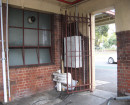KILBOGIE OUTSTATION
4022 WESTERN HIGHWAY TRAWALLA, PYRENEES SHIRE
-
Add to tour
You must log in to do that.
-
Share
-
Shortlist place
You must log in to do that.
- Download report
Statement of Significance
This record has minimal details. Please look to the right-hand-side bar for any further details about this record.
-
-
KILBOGIE OUTSTATION - History
Aboriginal occupation of the Trawalla area (the name is thought to mean 'wild water' or 'much rain') spans centuries and millennia, as recent investigations in the area have shown (Anderson et al. 2011). The first European settlers in Trawalla set up sheep and cattle grazing runs, and Trawalla station was established in 1838/9 (Anderson 1969). The early years of European settlement are recorded in Katherine Kirkland's memoir, 'Life in the Bush', published in 1845 (Anderson 1969). Following the discovery of gold in the Beaufort and Waterloo areas from the 1850s, Trawalla would have experienced growth, and it might have been the location of one of the coaching stations run by Cobb & Co. which operated a line along what is now the Western Highway. In the 1870s, the Ballarat to Ararat railway opened, and Trawalla station was located on this line, between Burrumbeet and Beaufort. There are a number of historical remains in the Trawalla district, some of which have been documented during a recent study (Anderson 2011).
The history of this particular site is poorly known. Its identification as 'Kilbogie Outstation' is based on an annotation on a map (,Plan of Fiery Creek Road from Ballarat to the Yam Holes') which dates from 1856. The map shows an area north of the road and west of a marsh, west of Mount Emu Creek (here called Trawalla Creek), which is marked 'Kilbogie / Outstation / R. and C. Simpson' and beside it are marked 'hut' and 'yard' (see below). The artefacts present and lack of visible structures on an aerial photograph of 1947 suggest that the site was probably abandoned by the early 20th century. The hand-made bricks and glass vessels suggest a mid-19th century (c.1840s-1860s). The usage of the site is unknown, though it is implied by the 'outstation' label, though this use may have changed over time. The site is located 200 m west of the former Trawalla School, VHI number H7523-0082 (Anderson 2011 , 93-4).
KILBOGIE OUTSTATION - Interpretation of Site
The site's identification as 'Kilbogie Oustation' is based on an annotated map of 1856. Documented artefacts suggest usage from 1850s or before. The site was demolished in probably the first half of the 20th century. A burnt layer containing historical-period artefacts, found during excavations, might relate to the site's destruction. There has been insufficient investigation to provide more in-depth interpretation.
KILBOGIE OUTSTATION - Archaeological Significance
The only structural remains identified are a line of bricks half a metre below the surface, which were found during a small excavation (1 m x 1 m pit). Otherwise, the site is consists of artefacts scattered on the surface and below ground, but not highly concentrated and in poor condition. There is unlikely to be significant or intact archaeological deposits present at the site
Heritage Inventory Description
KILBOGIE OUTSTATION - Heritage Inventory Description
Surface scatter of 19th-century ceramic, glass and brick and below ground artefacts and brick foundations, on an alluvial terrace west of Mount Emu Creek, Trawalla.
-
-
-
-
-
TRAWALLA SCHOOL
 Victorian Heritage Inventory
Victorian Heritage Inventory -
CHURCH ROAD SITE
 Victorian Heritage Inventory
Victorian Heritage Inventory -
AMAZON MINE
 Victorian Heritage Inventory
Victorian Heritage Inventory
-
-






